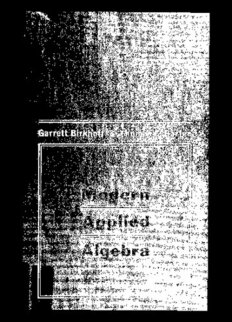Table Of ContentIndium AmmllHlod Algebra
u 7 dgm Applled Alg@bra
Garrett Birkhoff
DepartmentofMathematics
HarvardUniversity
and
Thomas C. Bartee
DivisionofEngineering
andAppliedPhysics
HarvardUniversity
McGraw-Hill BookCompany
NewYork,St.Louis,SanFrancisco,Diisuldorf,
London,Mexico,Panama,Sydney,Toronto
ThisbookwassetinModernbyTheMaplePressCompmy,
andboundbyTheMaplePressCompany.Thedesignerwas
MarshaCohen;thedrawingsweredonebyJosephBuchner.The~editors
wereDonaldK.PrentissandMaureenMcMahon.SallyR.Ellyson
supervisedtheproduction.
CorrectedThirdPrinting,1970 '
Mod-mAppliedAlgebra
Copyright©1970byMcGraw-Hill,Inc.Allrightsreserved.
PrintedintheUnitedStatesofAmerica.Nopartofthis
publicationmaybereproduced,storedinaretrievalsystem,
ortransmitted,inanyformorbyanymeans,electronic,
mechanical,photocopying,recording,orotherwise,without
thepriorwrittenpermissionofthepublisher‘
libraryofCanons;CatalogCardNumber70—88879
ISBN 07-005381-2‘
567890 MAMM 7987654321
Presses
The name “modern algebra” refers to the study of algebraic systems
(groups,rings,Booleanalgebras,etc.)whoseelementsaretypicallynon-
numer’ical. By contrast, “classical” algebrais basically concernedwith
algebraic equations or systems of equations whose symbols stand for
realorcomplexnumbers,Overthepast40years,“modern”algebrahas
beensteadilyreplacing“classical”algebrainAmericancollegecurricula.
Thepast20yearshaveseenanenormousexpansioninseveralnew
areas of technology. These new areas include digital computing, data
communication,andradarandsonarsystems.Workineachoftheseareas
reliesheavilyonmodernalgebra.Thisfacthasmadethestudyofmodern
algebraimportantto appliedmathematicians, engineers, and scientists
whousedigitalcomputersorwhoworkintheotherareasoftechnology
mentionedabove.
Thisbookattemptstopresentthoseideasandtechniquesofmodern
algebrawhichhaveprovedmostusefulfortheseareas.Althoughsome
separation is inevitable between the discussion of mathematical prin-
vi Preface
ciplesandtheirapplications,wehavetriedtoweavetogethertheunder-
lyingideasandthetechnicalalgorithmswhicharebasedonthem.
Thebookbeginsbypresentingandillustratingthenotionsofset,
function, mathematical induction, binary relation, and graph. Discus-
sions are also included ofBoolean algebras, monoids, morphisms, and
otherbasicalgebraicconcepts.Thismaterialconstitutestwochapters.
Inthenextchapterweintroducetheconceptsoffinite-statemachine
andTuringmachine, alongwithrepresentationschemesforthesetypes
ofmachines,andsystematictechniquesforreducingthenumberofstates
infinite-statemachines.Chapter4providesanintroductiontothedigital
computerprogramminglanguagecalledALGOLandtoitssyntax.
Chapter5introducestheaxiomaticapproachwhichissocharacter-
isticofmodernalgebra.Booleanalgebrasaredefinedformallybyappro—
priatepostulates,andthepropertiesofBooleanarededucedfromthese
postulates.Booleanalgebraisthenrelatedtologic,gatingnetworks,and
ALGOL programming, after which the canonical form for Boolean
polynomialsisderived.Chapter6centersaroundtheconceptofoptimiza-
tion, beginning with schemes for finding paths of least cost through
networks. Thentechniquesarepresentedfordescribingthegatingnet-
worksusedindigitalcomputers,andforsimplifyingthem(andthereby
reducing their cost) using Boolean polynomials. Finally, a method is
described for realizing an arbitrary finitestate machine by means of
gatesandflip-flop(memory)elements.
Chapter7presentsanaxiomatictreatmentofmonoidsandgroups.
It covers muchmore about monoids andsomewhat less about groups
thandomostbooksonmodernalgebra.Chapter8appliessomeofthese
ideastodatacommunicationssystemsinwhichnoisemayleadtoerrors
in the messages transmitted. Using the standard “binary symmetric
model” ofcommunicationstheoryto describetheprobabilityof error,
this chapterdescribestechniquesforgenerating, coding, and decoding
groupcodessoastooptimizetheirefficiencyindetectingandcorrecting
errors. Thisisfollowedbyachapteronlattices,whichshowshowfar-
reaching generalizations of Boolean algebra can be derived from the
studyofpartialorderingrelations. .
Chapter10dealswithringsandfields.Thischapteremphasizesthe
variouskindsofringswhichcanariseinapplications,relatesmorphisms
toideals, and discussesuniquefactorizationand Gaussianelimination.
Chapter 11 studies polynomial rings and applies polynomials to the
constructionandanalysisoferror-correctinganderror-detectingcodes.
FiniteorGaloisfieldsarestudiedinChapter12andareusedthere
to derive aspecial class of codes called Bose-Chaudhuri-Hoquenghem
codes.Chapter13thenintroducesdifferenceequationsandaparticular
classofcodeswhicharebasedondifferenceequationsandareusedwith
an‘ relation ‘ in ' " andradarsystems.
Preface vii
Chapter 14, thefinalchapter, thenpassesfromthefinitesystems
whichhavebeenstudieduptothispointtoinfinitesystems.Afteritis
shownthattherealnumbersareuncountable,theconceptofcomputability
isintroducedandrelatedtotheconceptofaTuringmachine. Finally,
thenotionofmachinecomputabilityisrelatedtoideasofmathematical
linguisticsandtotheclassificationofprogramminglanguages.
Anumberofdifferentcoursescanbedevelopedfromthematerial
inthisbook,whichcontainsmanystarredsectionswhichcanbeomitted
iftimerequires.AtHarvard,thematerialispresentedintwohalf-year
courses:AppliedMathematics106,primarilyanadvancedundergraduate
course, and Applied Mathematics 206, agraduate course. No specific
prerequisites are listed for Applied Mathematics 106. Because of the
basicnatureofthematerialcovered,thesecoursesareprerequisitesfor
a number of other courses Applied Mathematics 206 also includes a
shortintroductiontorealandcomplexmatrices,withemphasisonspecial
propertiesofmatricesarisinginvariousapplications;aboutone-thirdof
thetermisdevotedtothismaterial.
TheauthorsoweagreatdealtoJohnLipson,whocarefullyproofread
twodraftsofthebookinmanuscriptform,whocooperatedinwriting
ourexpositiononALGOL, andwhowroteourALGOLprograms.They
alsoowemuchtoAspiWadia,whoalsoproofreadthemanuscript,and
wroteoutcarefullywordedsolutionsformanyoftheexercises. Finally,
theywerehelpedbycriticismsandsuggestionsfrommanyfriends and
colleagues, including especially Donald Anderson, Marshall Hall,
Sesumo Kuno, Donald MacLaren, Albert Meyer, Werner Rheinboldt,
HartleyRogers,DavidSchneider,andHaoWang.
Cambridge,Massachusetts GarrettBirkhofi
April11,1969 ThomasC.Bartee

